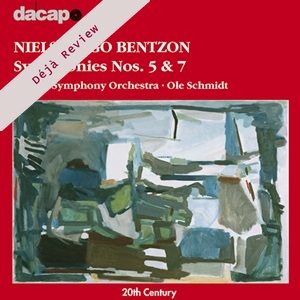
Déjà Review: this review was first published in January 2002 and the recording is still available.
Niels Viggo Bentzon (1909-2000)
Symphony No 5, Op 61 Ellipser (1950)
Symphony No 7, Op 83 Tre Versioner (1952)
Aarhus Symphony Orchestra/Ole Schmidt
rec. 1980 (Sym 7) and 1982 (Sym 5) Kongreshuset Aarhus
Dacapo 8.224111 [65]
The Fifth and Seventh symphonies are examples of Bentzon’s metamorphic style. The Fourth Symphony premiered only eight months before the Fifth was itself entitled Metamorphoses.
The Fifth Symphony is in five movements, together coaxing tension and channelling its release. The Moderato‘s fast under-pulse develops into an apocalyptic whirlpool. Solo violin lines chant out Hovhaness-like (6.20) amid a plangent bed of strings – Tippett-like. The urgency of the Allegro (II) gives place to remarkable visual metaphors suggestive of crystal caverns and pugnacious little marches. The Panufnik Tragic Overture has similar ragged brass descents. The Adagio is a great string edifice – essentially cold but warmed fitfully by furnace heat. Bentzon has also learnt something about the inexorable building of tension from Shostakovich. The second Allegro‘s fast-switching kaleidoscope is relieved by the dreamy Sostenuto. A high warble from the strings suggests supernatural fantasy. All is resolved in a cloud of held woodwind notes, descending into warm and classically poised repose.
The Seventh Symphony is from 1952. It is a single movement fusion of Bartók’s Concerto for Orchestra and 1940s vintage Shostakovich. Bentzon had his effect on Robert Simpson’s 4th and 5th symphonies and this can be heard here. Savage warlike skirls wrestle with terse little rhythmic cells, pithy, apophthegmatic, clipped yet speaking of a primal drive. There is the occasional shade, as at 16.34, of Nielsen 4 and 6. The work ends in a troubled peace, ruffled by fears and shaken by experience.
Rob Barnett
Help us financially by purchasing from



















